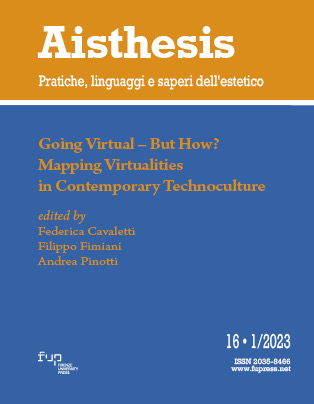Vol 16, No 1 (2023): Going Virtual – But How? Mapping Virtualities in Contemporary Technoculture
Issue Description
In recent years, Virtual Reality (a term coined by Jaron Lanier in the late Eighties of the last century) has become widely employed in different fields: from education to healthcare, from the military to professional training, from architecture to urban design, art production and display. First, the spread of this technology has promoted a revival of the notion of “virtuality”.
At the same time, however, it has induced a focus on a specific understanding of this notion (the technology-related one), which does not exhaust the broad historical and semantic spectrum of the virtual itself. What is more, despite such focus, the discourses around the virtual suffer from conceptual vagueness. This has been clearly shown during the Covid-19 pandemic, when “virtual” has become a buzzword for as diverse experiences as webinars, video calls, distance learning, and any sort of online interaction. At the end of the day, the virtual collapses onto the loose, and philosophically less pregnant, notion of “digital”. Given this scenario, it is urgent to shed light on the many “virtualities” underlying the currently widespread yet ambiguous notion of “virtual”.
Since the second half of the 20th century, the virtual has represented a major issue for the debate around the phenomenon of derealisation, which has variously engaged French thinkers (among which Gilles Deleuze, Jean Baudrillard, Paul Virilio, Pierre Lévy, Philippe Quéau) who explored the ontological relationship between virtuality and reality from different perspectives.
On its side, the subjective experience of the virtual has also been addressed from phenomenological and aesthetic perspectives. As for the former, Lambert Wiesing in Artificial Presence (Stanford University Press, 2010) has worked on how new media affect the traditional interpretation of the relationship between perception, image consciousness, and phantasy. As for the aesthetic approach, Grant Tavinor (in The Aesthetics of VirtualReality, Routledge 2022) has proposed to think of virtualisation in terms of remediation, i.e.a transformative process through which something maintains its function, while being instantiated in a non-customary way.
In the context of analytic philosophy, the ontological implications of virtual entities have been at the core of the discussion triggered by David Chalmers in relation to the nature of the virtual worlds, of the objects in them, and of the actions that can be performed in them.Should we define them as unreal, or should we rather speak of a different form of reality?In the latter case, what about the perception of (immersive) virtual worlds? And how isVirtual Reality to be interpreted in relation to different, yet associated technologies such asAugmented, Mixed, and Cross Reality, which articulate in as many different ways the interplay between the real and the virtual?
Given all the above, it is evident that the contemporary technologies of Virtual Reality, while posing stimulating questions to the philosophical reflection, are far from accounting for the conceptual richness of the notion of the virtual, which is in need of an in-depth critical examination.

